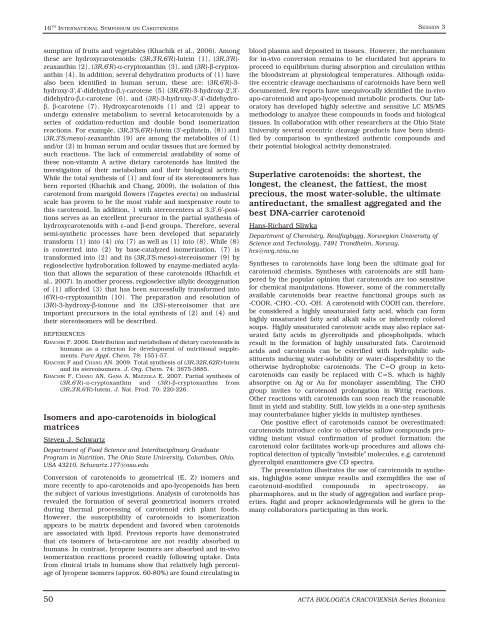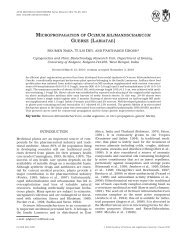ACTA BIOLOGICA CRACOVIENSIA
ACTA BIOLOGICA CRACOVIENSIA
ACTA BIOLOGICA CRACOVIENSIA
Create successful ePaper yourself
Turn your PDF publications into a flip-book with our unique Google optimized e-Paper software.
16 TH INTERNATIONAL SYMPOSIUM ON CAROTENOIDS<br />
sumption of fruits and vegetables (Khachik et al., 2006). Among<br />
these are hydroxycarotenoids: (3R,3'R,6'R)-lutein {1}, (3R,3'R)zeaxanthin<br />
{2}, (3R,6'R)-α-cryptoxanthin {3}, and (3R)-β-cryptoxanthin<br />
{4}. In addition, several dehydration products of {1} have<br />
also been identified in human serum, these are: (3R,6'R)-3hydroxy-3',4'-didehydro-β,γ-carotene<br />
{5} (3R,6'R)-3-hydroxy-2',3'didehydro-β,ε-carotene<br />
{6}, and (3R)-3-hydroxy-3',4'-didehydroβ,<br />
β-carotene {7}. Hydroxycarotenoids {1} and {2} appear to<br />
undergo extensive metabolism to several ketocarotenoids by a<br />
series of oxidation-reduction and double bond isomerization<br />
reactions. For example, (3R,3'S,6'R)-lutein (3'-epilutein, {8}) and<br />
(3R,3'S;meso)-zeaxanthin {9} are among the metabolites of {1}<br />
and/or {2} in human serum and ocular tissues that are formed by<br />
such reactions. The lack of commercial availability of some of<br />
these non-vitamin A active dietary carotenoids has limited the<br />
investigation of their metabolism and their biological activity.<br />
While the total synthesis of {1} and four of its stereoisomers has<br />
been reported (Khachik and Chang, 2009), the isolation of this<br />
carotenoid from marigold flowers (Tagetes erecta) on industrial<br />
scale has proven to be the most viable and inexpensive route to<br />
this carotenoid. In addition, 1 with stereocenters at 3,3',6'-positions<br />
serves as an excellent precursor in the partial synthesis of<br />
hydroxycarotenoids with ε–and β-end groups. Therefore, several<br />
semi-synthetic processes have been developed that separately<br />
transform {1} into {4} via {7} as well as {1} into {8}. While {8}<br />
is converted into {2} by base-catalyzed isomerization, {7} is<br />
transformed into {2} and its (3R,3'S;meso)-stereoisomer {9} by<br />
regioselective hydroboration followed by enzyme-mediated acylation<br />
that allows the separation of these carotenoids (Khachik et<br />
al., 2007). In another process, regioselective allylic deoxygenation<br />
of {1} afforded {3} that has been successfully transformed into<br />
(6'R)-α-cryptoxanthin {10}. The preparation and resolution of<br />
(3R)-3-hydroxy-β-ionone and its (3S)-stereoisomer that are<br />
important precursors in the total synthesis of {2} and {4} and<br />
their stereoisomers will be described.<br />
REFERENCES<br />
KHACHIK F. 2006. Distribution and metabolism of dietary carotenoids in<br />
humans as a criterion for development of nutritional supplements.<br />
Pure Appl. Chem. 78: 1551-57.<br />
KHACHIK F and CHANG AN. 2009. Total synthesis of (3R,32R,62R)-lutein<br />
and its stereoisomers. J. Org. Chem. 74: 3875-3885.<br />
KHACHIK F, CHANG AN, GANA A, MAZZOLA E. 2007. Partial synthesis of<br />
(3R,6'R)-α-cryptoxanthin and (3R)-β-cryptoxanthin from<br />
(3R,3'R,6'R)-lutein. J. Nat. Prod. 70: 220-226.<br />
Isomers and apo-carotenoids in biological<br />
matrices<br />
Steven J. Schwartz<br />
Department of Food Science and Interdisciplinary Graduate<br />
Program in Nutrition, The Ohio State University, Columbus, Ohio,<br />
USA 43210. Schwartz.177@osu.edu<br />
Conversion of carotenoids to geometrical (E, Z) isomers and<br />
more recently to apo-carotenoids and apo-lycopenoids has been<br />
the subject of various investigations. Analysis of carotenoids has<br />
revealed the formation of several geometrical isomers created<br />
during thermal processing of carotenoid rich plant foods.<br />
However, the susceptibility of carotenoids to isomerization<br />
appears to be matrix dependent and favored when carotenoids<br />
are associated with lipid. Previous reports have demonstrated<br />
that cis isomers of beta-carotene are not readily absorbed in<br />
humans. In contrast, lycopene isomers are absorbed and in-vivo<br />
isomerization reactions proceed readily following uptake. Data<br />
from clinical trials in humans show that relatively high percentage<br />
of lycopene isomers (approx. 60-80%) are found circulating in<br />
SESSION 3<br />
blood plasma and deposited in tissues. However, the mechanism<br />
for in-vivo conversion remains to be elucidated but appears to<br />
proceed to equilibrium during absorption and circulation within<br />
the bloodstream at physiological temperatures. Although oxidative<br />
eccentric cleavage mechanisms of carotenoids have been well<br />
documented, few reports have unequivocally identified the in-vivo<br />
apo-carotenoid and apo-lycopenoid metabolic products. Our laboratory<br />
has developed highly selective and sensitive LC MS/MS<br />
methodology to analyze these compounds in foods and biological<br />
tissues. In collaboration with other researchers at the Ohio State<br />
University several eccentric cleavage products have been identified<br />
by comparison to synthesized authentic compounds and<br />
their potential biological activity demonstrated.<br />
Superlative carotenoids: the shortest, the<br />
longest, the cleanest, the fattiest, the most<br />
precious, the most water-soluble, the ultimate<br />
antireductant, the smallest aggregated and the<br />
best DNA-carrier carotenoid<br />
Hans-Richard Sliwka<br />
Department of Chemistry, Realfagbygg, Norwegian University of<br />
Science and Technology, 7491 Trondheim, Norway,<br />
hrs@nvg.ntnu.no<br />
Syntheses to carotenoids have long been the ultimate goal for<br />
carotenoid chemists. Syntheses with carotenoids are still hampered<br />
by the popular opinion that carotenoids are too sensitive<br />
for chemical manipulations. However, some of the commercially<br />
available carotenoids bear reactive functional groups such as<br />
-COOR, -CHO, -CO, -OH. A carotenoid with COOH can, therefore,<br />
be considered a highly unsaturated fatty acid, which can form<br />
highly unsaturated fatty acid alkali salts or inherently colored<br />
soaps. Highly unsaturated carotenoic acids may also replace saturated<br />
fatty acids in glycerolipids and phospholipids, which<br />
result in the formation of highly unsaturated fats. Carotenoid<br />
acids and carotenols can be esterified with hydrophilic substituents<br />
inducing water-solubility or water-dispersibility to the<br />
otherwise hydrophobic carotenoids. The C=O group in ketocarotenoids<br />
can easily be replaced with C=S, which is highly<br />
absorptive on Ag or Au for monolayer assembling. The CHO<br />
group invites to carotenoid prolongation in Wittig reactions.<br />
Other reactions with carotenoids can soon reach the reasonable<br />
limit in yield and stability. Still, low yields in a one-step synthesis<br />
may counterbalance higher yields in multistep syntheses.<br />
One positive effect of carotenoids cannot be overestimated:<br />
carotenoids introduce color to otherwise sallow compounds providing<br />
instant visual confirmation of product formation; the<br />
carotenoid color facilitates work-up procedures and allows chiroptical<br />
detection of typically "invisible" molecules, e.g. carotenoid<br />
glycerolipid enantiomers give CD spectra.<br />
The presentation illustrates the use of carotenoids in synthesis,<br />
highlights some unique results and exemplifies the use of<br />
carotenoid-modified compounds in spectroscopy, as<br />
pharmaphores, and in the study of aggregation and surface properties.<br />
Right and proper acknowledgements will be given to the<br />
many collaborators participating in this work.<br />
50 <strong>ACTA</strong> <strong>BIOLOGICA</strong> <strong>CRACOVIENSIA</strong> Series Botanica












